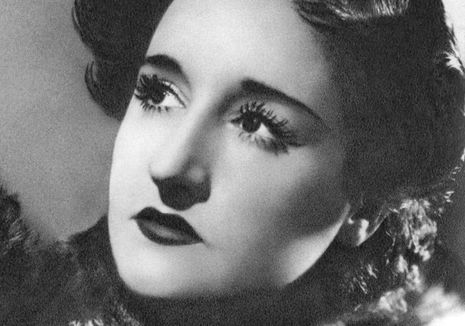How Spain’s forgotten feminists used balloons as tools of resistance
Forget Dalí and Buñuel, it’s time to doff your hat to the unsung suffragettes of the Generation of ‘27

The alumni of Spain’s Generation of 1927 have become household names: from Salvador Dalí to Luis Buñuel, the legacy of the filmmakers, painters and poets from Spain’s Silver Age are staple figures in Spanish culture. Originating as an influential cluster of ten Spanish poets, including Manuel Altolaguirre and Pedro Salinas, their circle later grew to become one of the world’s most famous avant-garde movements. The lasting legacy of the Generation prevails in global culture almost a century later. From the National Theatre’s 2017 productions of Frederico García Lorca’s ‘Yerma’, to the permanent collection of Óscar Domínguez’s paintings in New York’s Museum of Modern Art, a quick internet search reveals countless devotions to the creators of the Generation of ’27. Yet, there appears to be an absence among the accolades, as accounts of Spain’s Silver Age celebs seem to gloss over a rather crucial component: the women.
“The women of Gen ’27 dared to defy gender odds, one inflated companion at a time”
When we think of Spain’s most prolific 20th Century pioneers, names like Dalí and Lorca immediately spring to mind. But can you name any Spanish women from the period? Or, more specifically, any Spanish women from the period...without hats? It’s time to introduce the history books to Las Sinsombrero (Hatless Women): the balloon-bearing revolutionaries of the Generation of ’27. With women yet to get the vote, Spain in the late 1920s was far from fair; until 1931, the 1870 Penal Code and the 1889 Civil Code were still in action, asserting women’s role as the ‘ángel de hogar’ (angel of the house) or ‘la perfecta casada’ (the perfect housewife) in their legislation. Outside of the home, women were expected to cover their hair with a hat to signal respectability, modesty and virtue.
Determined to let their hair down, Gen ’27 painters Maruja Mallo and Margarita Manso decided to fight back. In 1927, accompanied by their famed co-workers, Dalí and Lorca, the two women set foot in the Spanish capital, traversing Madrid’s Puerta del Sol completely hat-free. In an interview for the RTVE documentary ’Las Sinsombrero’, Maruja Mallo explained the ordeal thus: “One fine day...it occurred to us to take off our hats...and as we crossed the Puerta del Sol, they stoned us. People thought we were completely immoral, as though we weren’t wearing any clothes”. Undeterred by the violence, Mallo and Manso thought of a solution: next time they went out on a hatless expedition, they would tie a balloon to their wrist, and put their hat on it instead. “The moment we met someone [that] we knew,” Mallo explains, “we would tip the hat of the balloon”.
Their peculiarity proved popular: soon after, other female members of the Generation of ’27, including the poet Concha Méndez and the socialist activist Margarita Nelken, joined in with the bare-headed bravery. Doffing the hat of their balloons in an eccentric act of resistance, the women of Gen ’27 dared to defy gender odds, one inflated companion at a time. Yet there is far more to these fearless females than their balloon-based behaviour. Despite their work being ‘undervalued or ignored in comparison to their male contemporaries’, as an article from Madrid’s Reina Sofía Museum puts it, its significance is clear.
“People thought they were completely immoral, as though they weren’t wearing any clothes”
Described by José Antonio Mesa, the director of the Cultural Centre of the Generation of ’27, as ‘the great painter of the century’, Maruja Mallo’s oil paintings are influential and unique. Amongst her masterpieces is a collection of four large polychromatic oil paintings depicting subversions of religious festivals, each entitled ’La Verbena’ (The Fair). Mallo’s tetrad of paintings, according to Professor Shirley Mangini at California State University, heavily inspired her male counterparts with their “chaos and hilarity”. Mallo’s four paintings were so influential, Mangini contends, that two of Spain’s most preeminent poets, Rafael Alberti and Miguel Hernández “revered her” and were “influenced by her art” in their writings.
In defiance of societal wishes for women to be housebound hermits, the work of fellow Sinsombrero Concha Méndez was no less extraordinary. Determined to include women in intellectual discussions, Méndez co-founded Madrid’s Lyceum Club in 1926, a women’s cultural organisation which aimed to foster intellectual conversations among the women of Spain. Typically, her self-belief was shunned, as Professor Ciara McGrath at Washington University states “the club was viewed as a real calamity for the home and a natural enemy of the family, and above all, of the husband.” Despite the club’s controversy, Méndez continued to produce numerous poems and plays. Her oeuvres, of which the poems ’Surtidor’ (1928), and ’Canciones de mar y tierra’ (1930) are the most famous, pertinently portraying, says McGrath, her “self-emancipation, and her independent spirit”.
Méndez and Mallo are just two of the eight female members of the Generation of ’27, all of whom have been virtually hidden from history, undervalued, and under celebrated. However, there is still work to be done: in a 2016 article from Spain’s national newspaper, El País, the women were dismissively titled ‘Las amigas de Buñuel Dalí y Lorca’ (The friends of Buñuel Dalí and Lorca). Irrespective of their acclaimed male counterparts, the creativity, courage, and charisma of Las Sinsombrero should serve as an inspiring reminder of the women who shaped the world through wit. Through painting, poetry and persistence, the women of the Generation of ’27 have taught us that fighting for freedom can be as simple as blowing up a balloon. And for that, we take our hats off to them!
 News / Cambridge study finds students learn better with notes than AI13 December 2025
News / Cambridge study finds students learn better with notes than AI13 December 2025 Features / Should I stay or should I go? Cambridge students and alumni reflect on how their memories stay with them15 December 2025
Features / Should I stay or should I go? Cambridge students and alumni reflect on how their memories stay with them15 December 2025 News / Uni Scout and Guide Club affirms trans inclusion 12 December 2025
News / Uni Scout and Guide Club affirms trans inclusion 12 December 2025 Comment / The magic of an eight-week term15 December 2025
Comment / The magic of an eight-week term15 December 2025 News / Cambridge Vet School gets lifeline year to stay accredited28 November 2025
News / Cambridge Vet School gets lifeline year to stay accredited28 November 2025









